Developing Computational Thinking Abilities in the Early Years Using Guided Play Activities
Abstract
1. Introduction
1.1. What Is Computational Thinking?
1.2. Teaching and Assessing Computational Thinking in Young Children
1.3. The Present Study
1.4. Research Questions
- 1.
- Were the tasks appropriate for the ages and abilities of the children and allow scaffolding of learning?
- 2.
- Did the children’s behaviour and explanations demonstrate evidence of emerging CT abilities?
2. Methods and Materials
2.1. Design
2.2. Participants
2.3. Ethical Approval and Informed Consent
2.4. Materials and Activity
2.5. Quantitative Data Analysis
2.6. Qualitative Data Analysis
3. Results
3.1. Task A
3.2. Task B
3.3. Examples of Verbal and Non-Verbal Communication
4. Discussion
Limitations and Implications
5. Conclusions
Author Contributions
Funding
Institutional Review Board Statement
Informed Consent Statement
Data Availability Statement
Conflicts of Interest
References
- Armoni, M. (2016). Computing in schools, computer science, computational thinking, programming, coding: The anomalies of transitivity in K-12 computer science education. ACM Inroads, 7(4), 24–27. [Google Scholar] [CrossRef]
- Becker, I., Rigaud, V. M., & Epstein, A. (2023). Getting to know young children: Alternative assessments in early childhood education. Early Childhood Education Journal, 51(5), 911–923. [Google Scholar] [CrossRef]
- Bers, K. (2021). Coding as a playground: Programming and computational thinking in the early childhood classroom (eye on education). Routledge. [Google Scholar]
- Bers, M., Flannery, L., Kazakof, E., & Sullivan, A. (2014). Computational thinking and tinkering: Exploration of an early childhood robotics curriculum. Computers and Education, 72, 145–157. [Google Scholar] [CrossRef]
- Bers, M. U. (2018). Coding and computational thinking in early childhood: The impact of ScratchJr in Europe. European Journal of STEM Education, 3(3), 8. [Google Scholar] [CrossRef] [PubMed]
- Brennan, K., & Resnick, M. (2012, April 13–17). New frameworks for studying and assessing the development of computational thinking. The 2012 Annual Meeting of the American Educational Research Association (Vol. 1, p. 25), Vancouver, BC, Canada. [Google Scholar]
- Bull, G., Garofalo, J., & Rich Hguyen, N. (2020). Thinking about computational thinking. Journal of Digital Learning in Teacher Education, 36(1), 6–18. [Google Scholar] [CrossRef]
- Bull, R., & Scerif, G. (2001). Executive functioning as a predictor of children’s mathematics ability: Inhibition, switching, and working memory. Developmental Neuropsychology, 19(3), 273–293. [Google Scholar] [CrossRef] [PubMed]
- Critten, V., Hagon, H., & Messer, D. (2022). Can pre-school children learn programming and coding through guided play activities? A case study in computational thinking. Early Childhood Education Journal, 50(6), 969–981. [Google Scholar] [CrossRef]
- Critten, V., Hagon, H., & Unlu, M. A. (2024). A Curriculum framework and assessment approach for computational thinking in the early years. International Journal of Computer Science Education in Schools, 6(4). [Google Scholar] [CrossRef]
- Department for Education (DfE). (2013). National curriculum in England: Computing programmes of study. National curriculum—Computing key stages 1 to 2. Available online: https://www.gov.uk/government/publications/national-curriculum-in-england-computing-programmes-of-study/national-curriculum-in-england-computing-programmes-of-study (accessed on 1 January 2023).
- Department for Education (DfE). (2023). Early years foundation stage statutory framework. Statutory Framework for the Early Years Foundation Stage.
- Dong, C. (2018). ‘Young children nowadays are very smart in ICT’—Preschool teachers’ perceptions of ICT use. International Journal of Early Years Education, 33(2), 345–358. [Google Scholar] [CrossRef]
- Fessakis, G., Gouli, E., & Mavroudi, E. (2013). Problem solving by 5–6 years old kindergarten children in a computer programming environment: A case study. Computers and Education, 63, 87–97. [Google Scholar] [CrossRef]
- Fleer, M. (2021). Re-imagining play spaces in early childhood education: Supporting girls’ motive orientation to STEM in times of COVID-19. Journal of Early Childhood Research, 19(1), 3–20. Available online: https://uk.sagepub.com/en-gb/journals-permissions (accessed on 1 January 2023). [CrossRef]
- Flood, V. J., Wang, X. C., & Sheridan, M. (2022, June 6–10). Embodied responsive teaching for supporting computational thinking in early childhood. The 16th International Conference of the Learning Sciences-ICLS 2022 (pp. 855–862), Hiroshima, Japan. [Google Scholar]
- Gomes, T. C. S., Falcão, T. P., & Tedesco, P. C. D. A. R. (2018). Exploring an approach based on digital games for teaching programming concepts to young children. International Journal of Child-Computer Interaction, 16, 77–84. [Google Scholar] [CrossRef]
- Hagon, H., Critten, V., & Messer, D. (2020). An introduction to unplugged coding for preschool children. Hello World, 13, 57–59. Available online: https://helloworld.raspberrypi.org/issues/13 (accessed on 9 September 2025).
- International Society for Technology in Education (ISTE) & The Computer Science Teachers Association (CSTA). (2011). Operational definition of computational thinking for K–12. Education. Available online: https://cdn.iste.org/www-root/Computational_Thinking_Operational_Definition_ISTE.pdf (accessed on 9 September 2025).
- Kanaki, K., & Kalogiannakis, M. (2022, September 16–18). Algorithmic thinking in early childhood. The 6th International Conference on Digital Technology in Education (pp. 66–71), Hangzhou, China. [Google Scholar] [CrossRef]
- Karmiloff-Smith, A. (1995). Beyond modularity: A developmental perspective on cognitive science (learning, development, and conceptual change). MIT Press. [Google Scholar]
- Lee, J., Joswick, C., & Pole, K. (2023). Classroom play and activities to support computational thinking development in early childhood. Early Childhood Education Journal, 51(3), 457–468. [Google Scholar] [CrossRef]
- Lee, J., & Junoh, J. (2019). Implementing unplugged coding activities in early childhood classrooms. Early Childhood Education Journal, 47(6), 709–716. [Google Scholar] [CrossRef]
- Lee, K., & Cho, J. (2021). Computational thinking evaluation tool development for early childhood software education. JOIV: International Journal on Informatics Visualization, 5(3), 313–319. [Google Scholar]
- Papert, S. (1988). Does easy do it? Children, games, and learning. Game Developer Magazine, 5(6), 88–89. [Google Scholar]
- Papert, S. (1990). Mindstorms: Children, computers and powerful ideas. New York: Basic Books, 10(1990), 1095592. [Google Scholar]
- Papert, S., & Harel, I. (1991). Situating constructionism. Available online: http://www.papert.org/articles/SituatingConstructionism.htm (accessed on 1 January 2023).
- Pine, K. J., & Messer, D. J. (2000). The effect of explaining another’s actions on children’s implicit theories of balance. Cognition and Instruction, 18(1), 35–51. [Google Scholar] [CrossRef]
- Presser, A. E. L., Young, J. M., Rosenfeld, D., Clements, L. J., Kook, J. F., Sherwood, H., & Cerrone, M. (2023). Data collection and analysis for preschoolers: An engaging context for integrating mathematics and computational thinking with digital tools. Early Childhood Research Quarterly, 65, 42–56. [Google Scholar] [CrossRef]
- Relkin, E., & Strawhacker, A. (2021). Unplugged learning: Recognizing computational thinking in everyday life. In M. Bers (Ed.), Teaching computational thinking and coding to young children (pp. 41–62). IGI Global Scientific Publishing. Available online: https://www.igi-global.com/chapter/unplugged-learning/286042 (accessed on 1 January 2023).
- Seidman, R. H. (1989). Computer programming and logical reasoning: Unintended cognitive effects. Journal of Educational Technology Systems, 18(2), 123–141. [Google Scholar] [CrossRef]
- Siegler, R. S. (2016). Continuity and change in the field of cognitive development and in the perspectives of one cognitive developmentalist. Child Development Perspectives, 10(2), 128–133. [Google Scholar] [CrossRef]
- Spadafora, N., & Downes, T. (2020). Scaffolding in learning. In Encyclopedia of evolutionary psychological science. Springer Nature Switzerland AG. [Google Scholar]
- Terroba, M., Ribera, J. M., Lapresa, D., & Anguera, M. T. (2022). Observational analysis of the development of computational thinking in early childhood education (5 years old) through an intervention proposal with a ground robot of programmed directionality. European Early Childhood Education Research Journal, 30(3), 437–455. [Google Scholar] [CrossRef]
- Trentin, M. A. S., Pazinato, A., & Teixeira, A. C. (2017). The development of mathematical logical reasoning through computer programming: The case of the computer programming Olympics for basic education students. Creative Education, 8(1), 81. [Google Scholar] [CrossRef]
- Vygotsky, L. S., Cole, M., John-Steiner, V., & Souberman, E. (1980). Mind in society: The development of higher psychological processes. Harvard University Press. [Google Scholar]
- Wang, X. C., Choi, Y., Benson, K., Eggleston, C., & Weber, D. (2021a). Teacher’s role in fostering preschoolers’ computational thinking: An exploratory case study. Early Education and Development, 32(1), 26–48. [Google Scholar] [CrossRef]
- Wang, X. C., Flood, V. J., & Cady, A. (2021b, June 8–11). Computational thinking through body and ego syntonicity: Young children’s embodied sense-making using a programming toy. The 15th International Conference of the Learning Sciences-ICLS 2021, Bochum, Germany. [Google Scholar]
- Wang, X. C., Flood, V. J., & Xing, G. Y. (2023, June 9–10). Preschoolers’ embodied and shared self-regulation through computational thinking. The 17th International Conference of the Learning Sciences-ICLS 2023 (pp. 1470–1473), Montreal, QC, Canada. [Google Scholar]
- Wing, J. M. (2006). Computational thinking. Communications of the ACM, 49(3), 33–35. [Google Scholar] [CrossRef]
- Yildirim, B. (2021). Preschool STEM activities: Preschool teachers’ preparation and views. Early Childhood Education Journal, 49(2), 149–162. [Google Scholar] [CrossRef]
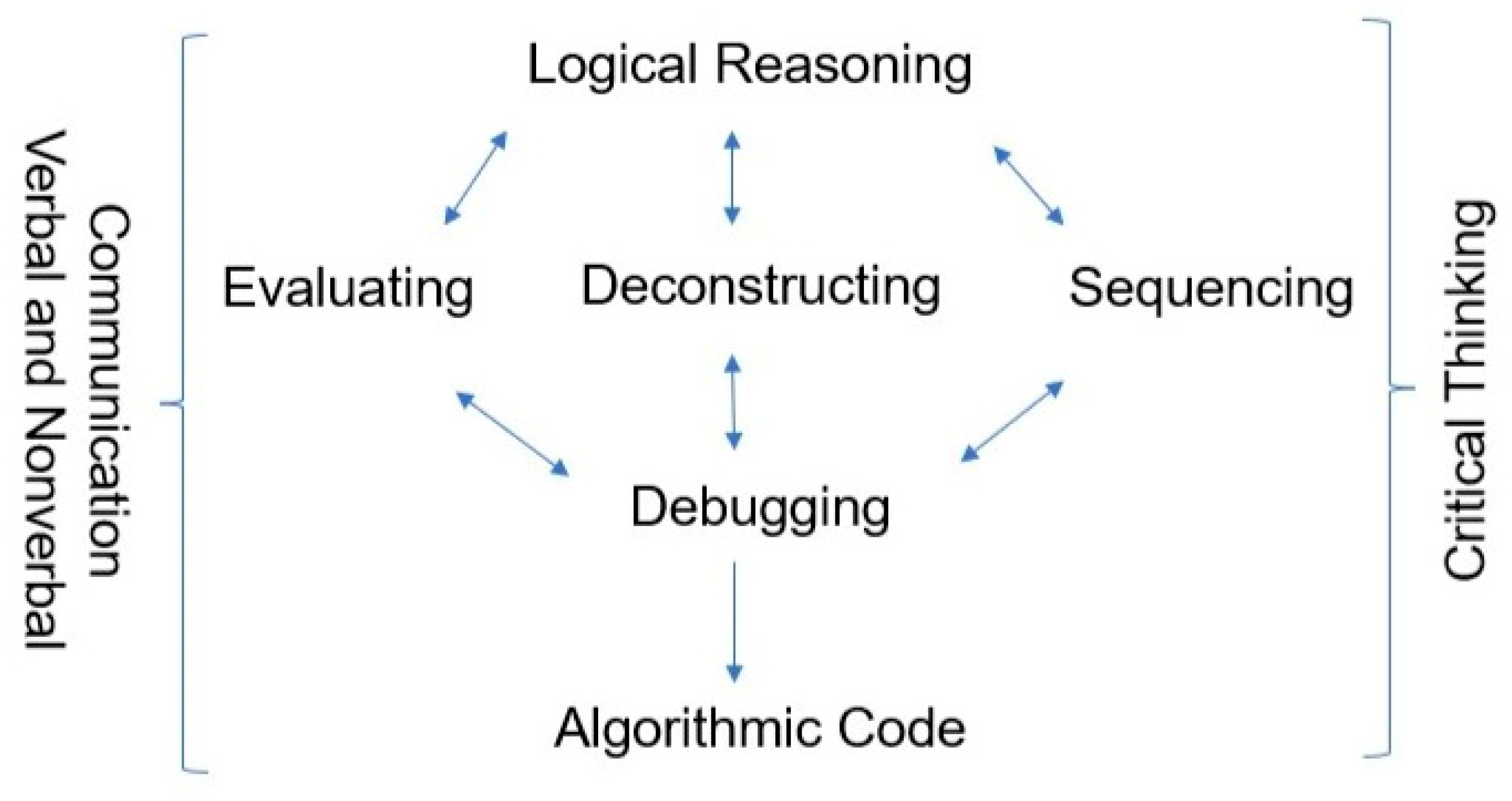
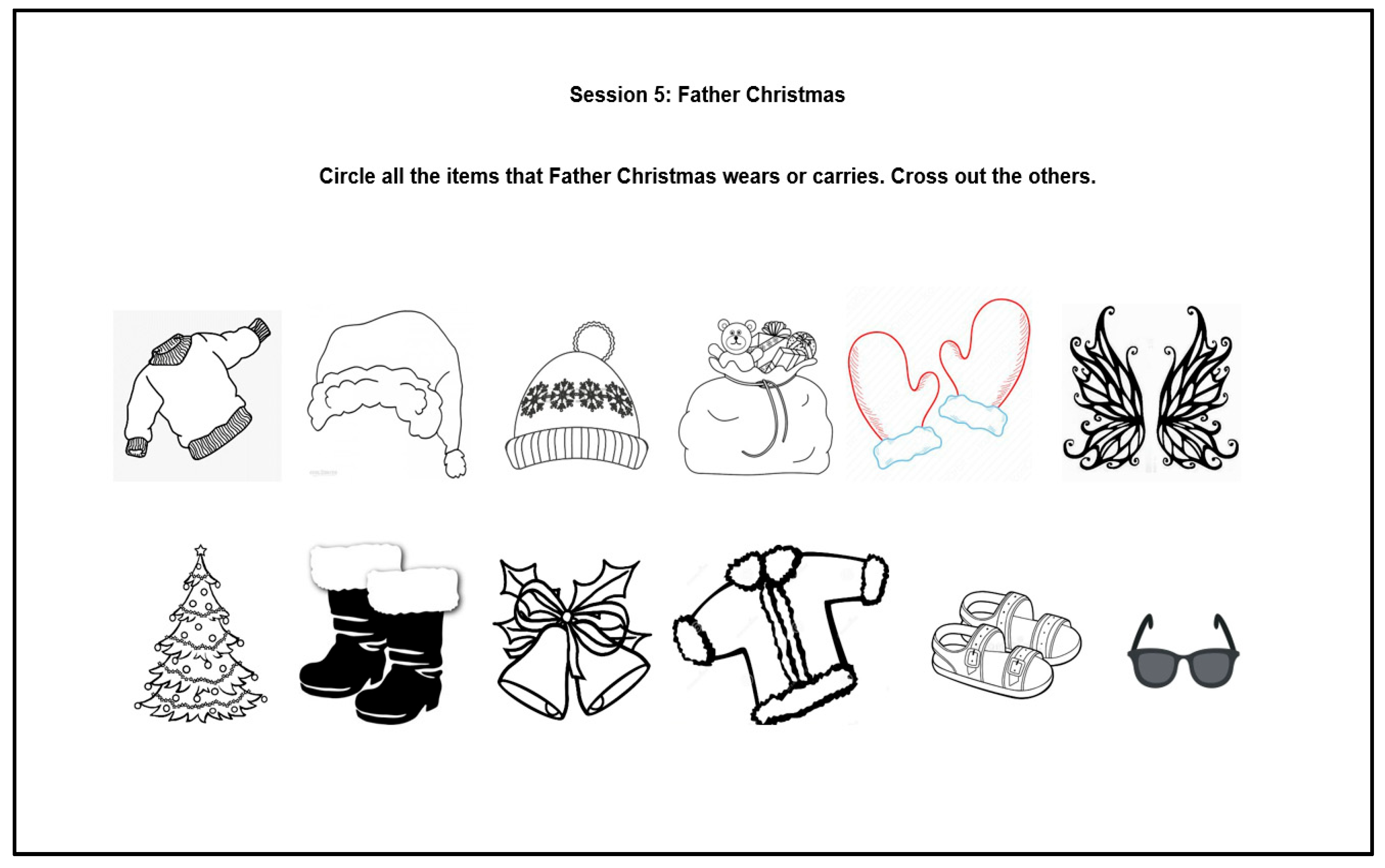
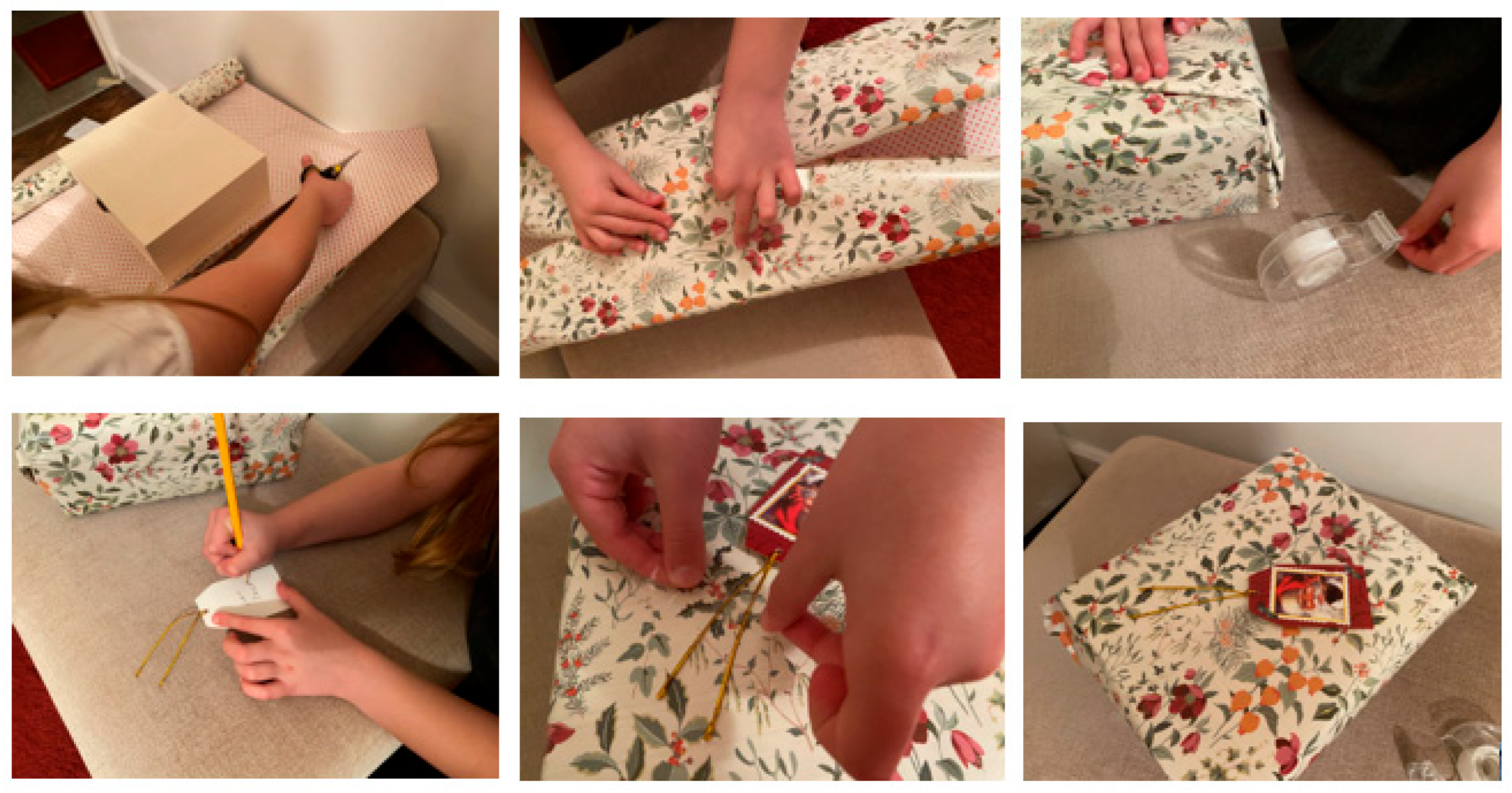
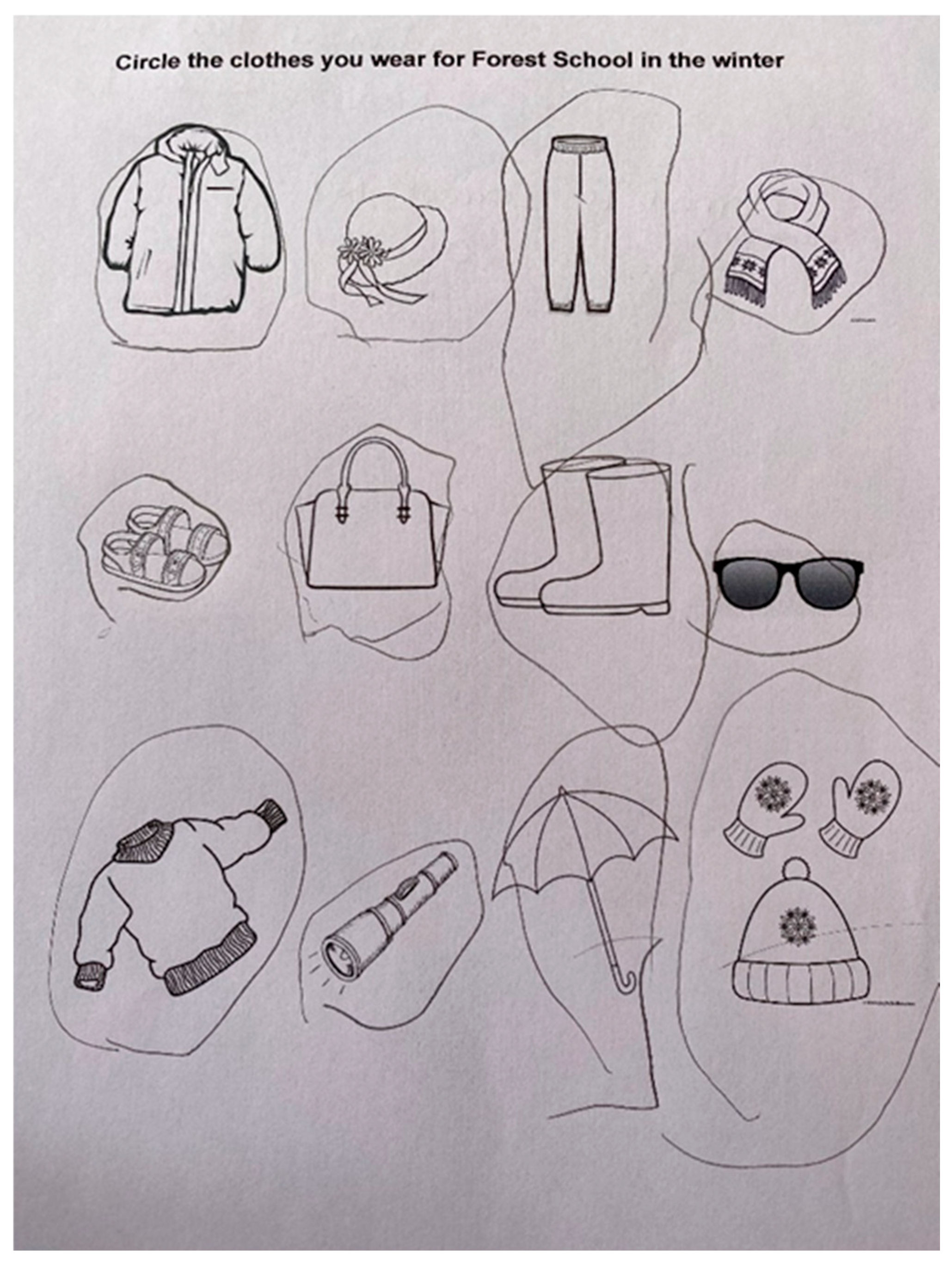
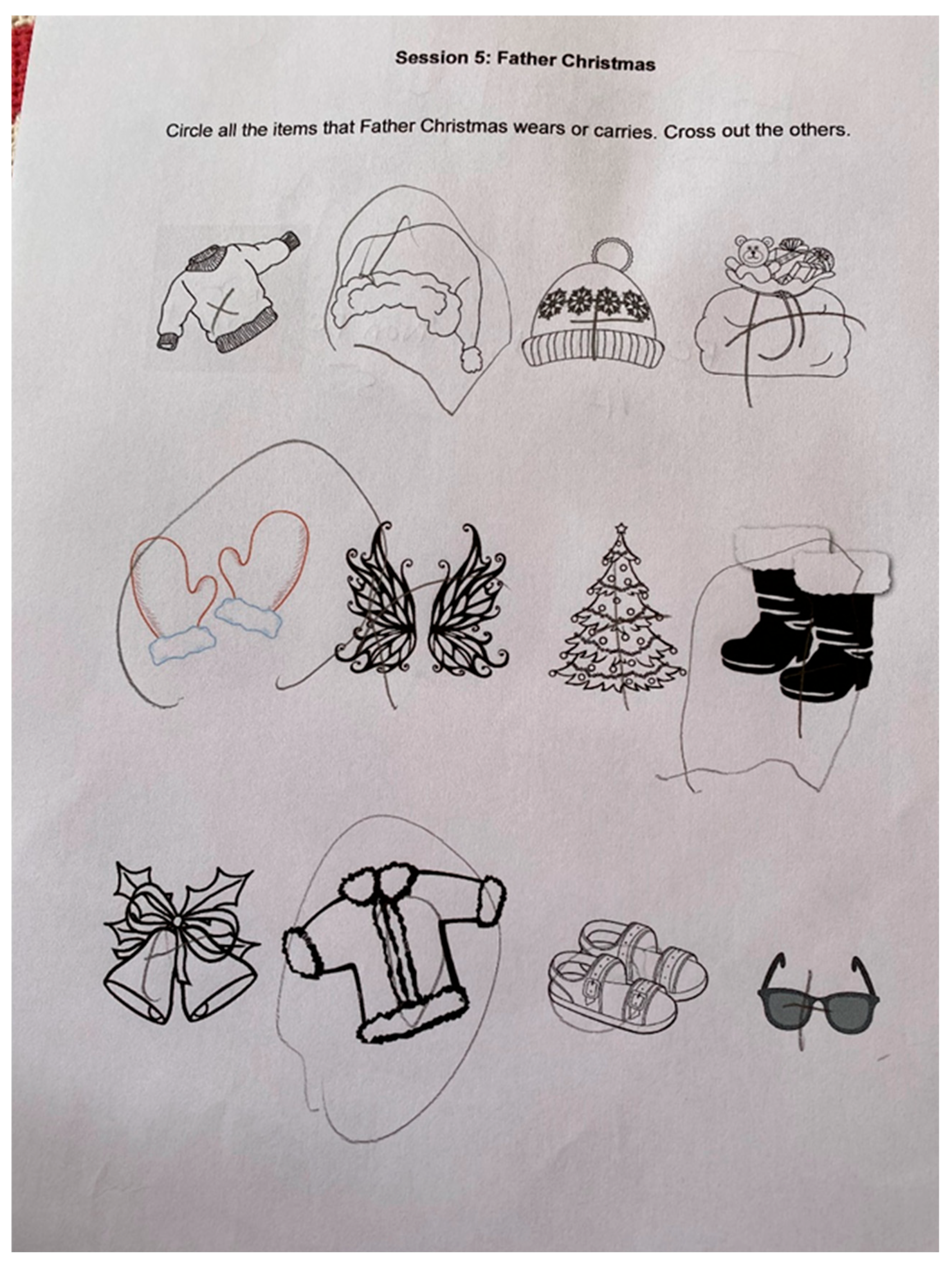
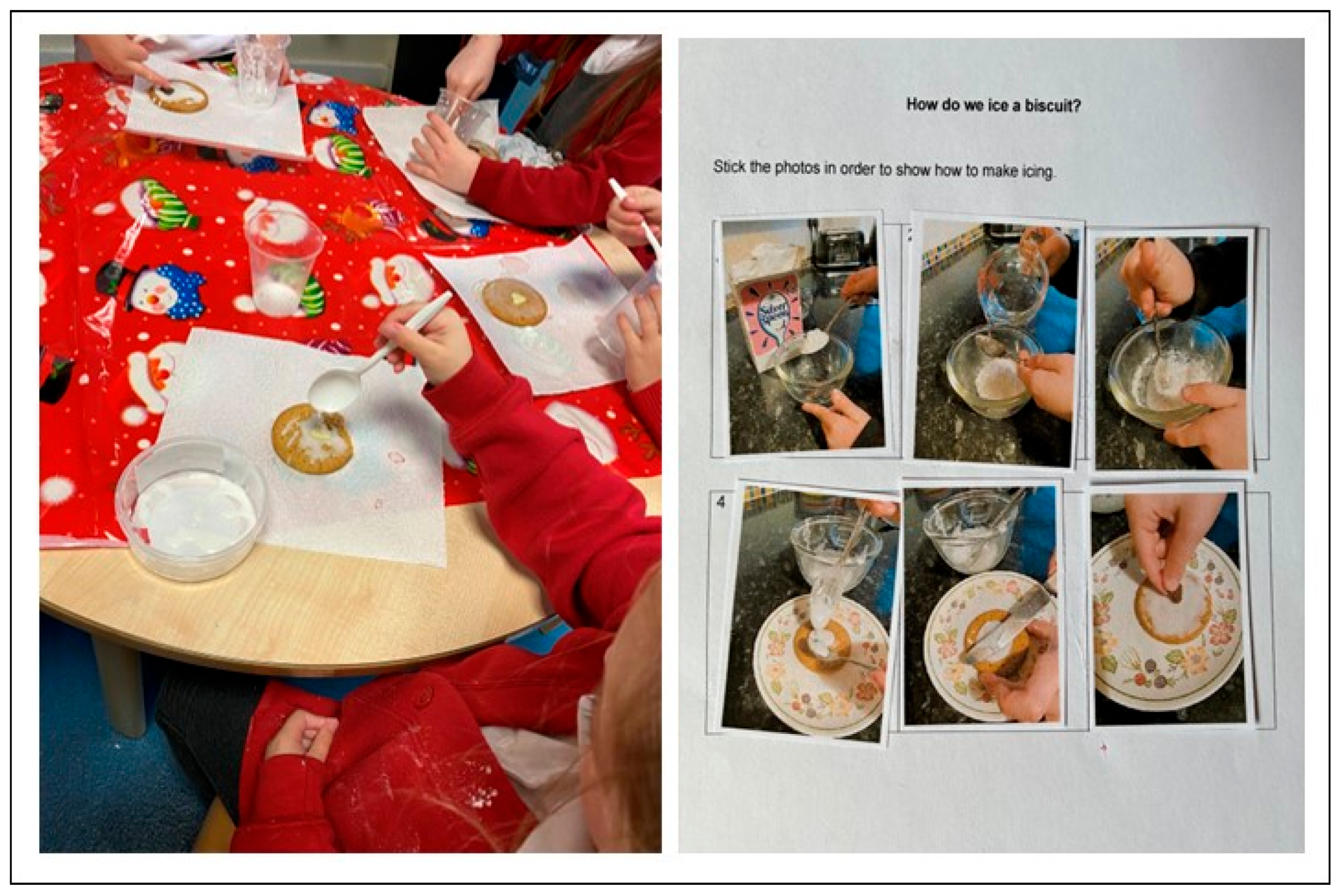
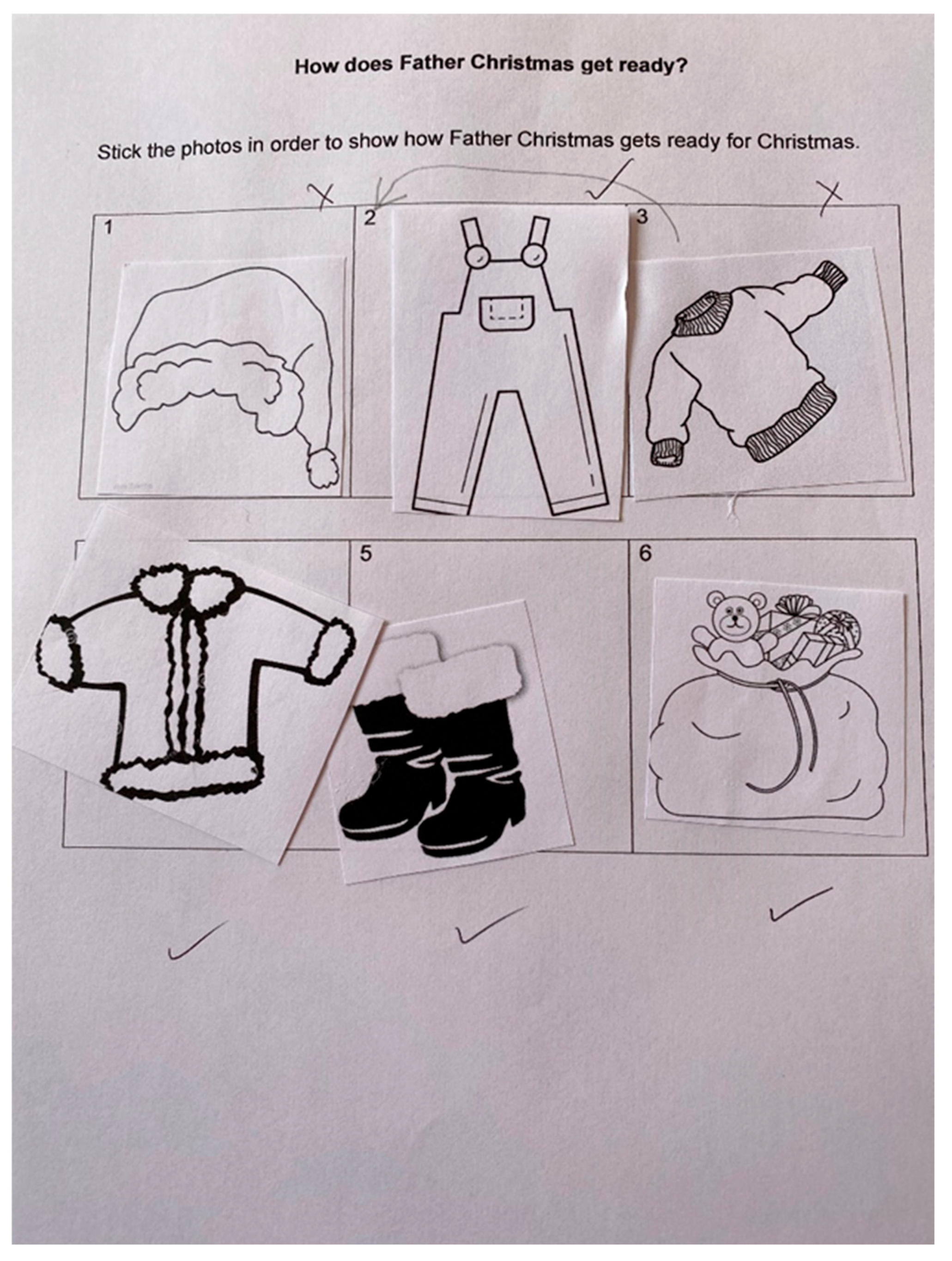
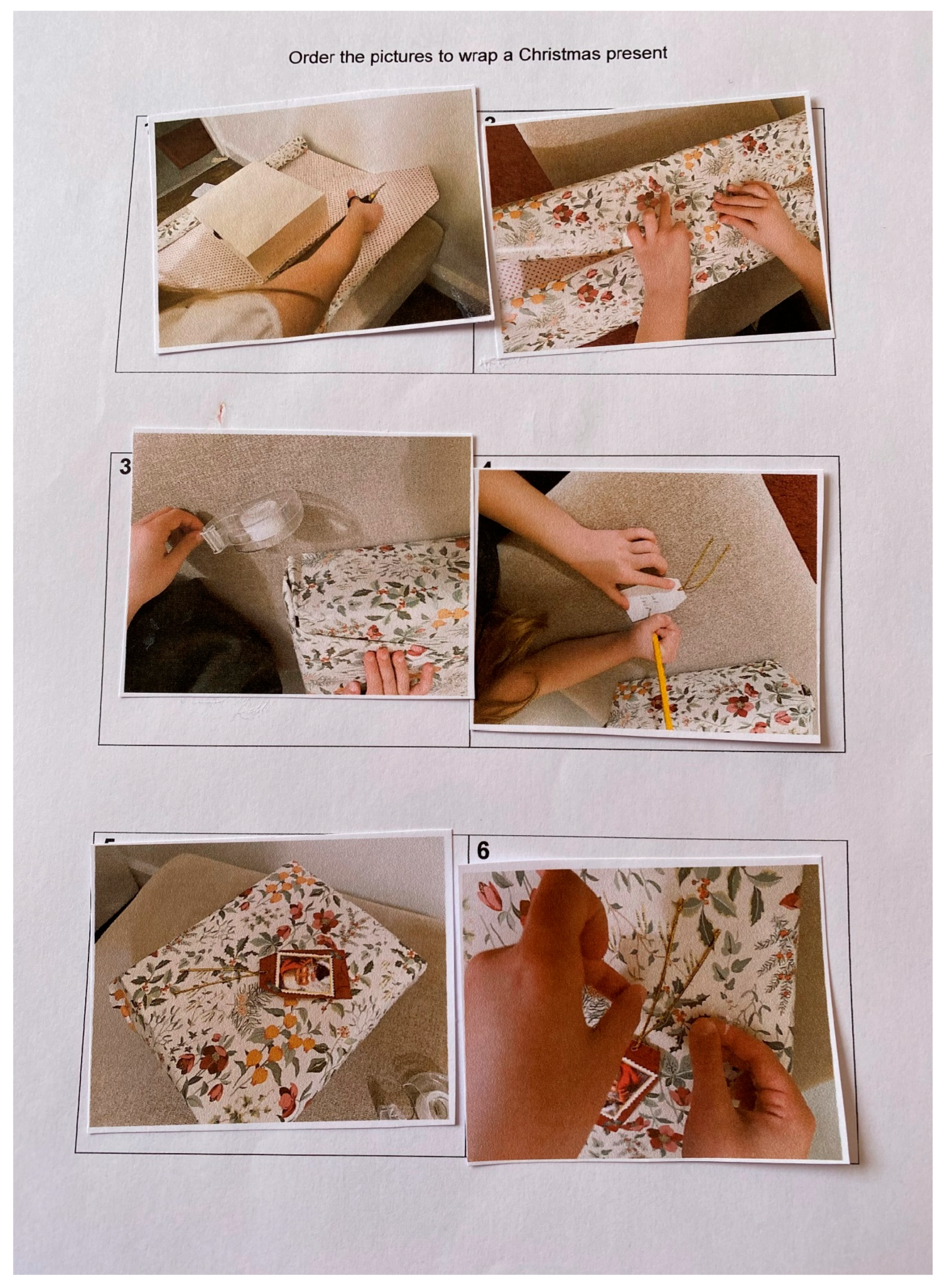
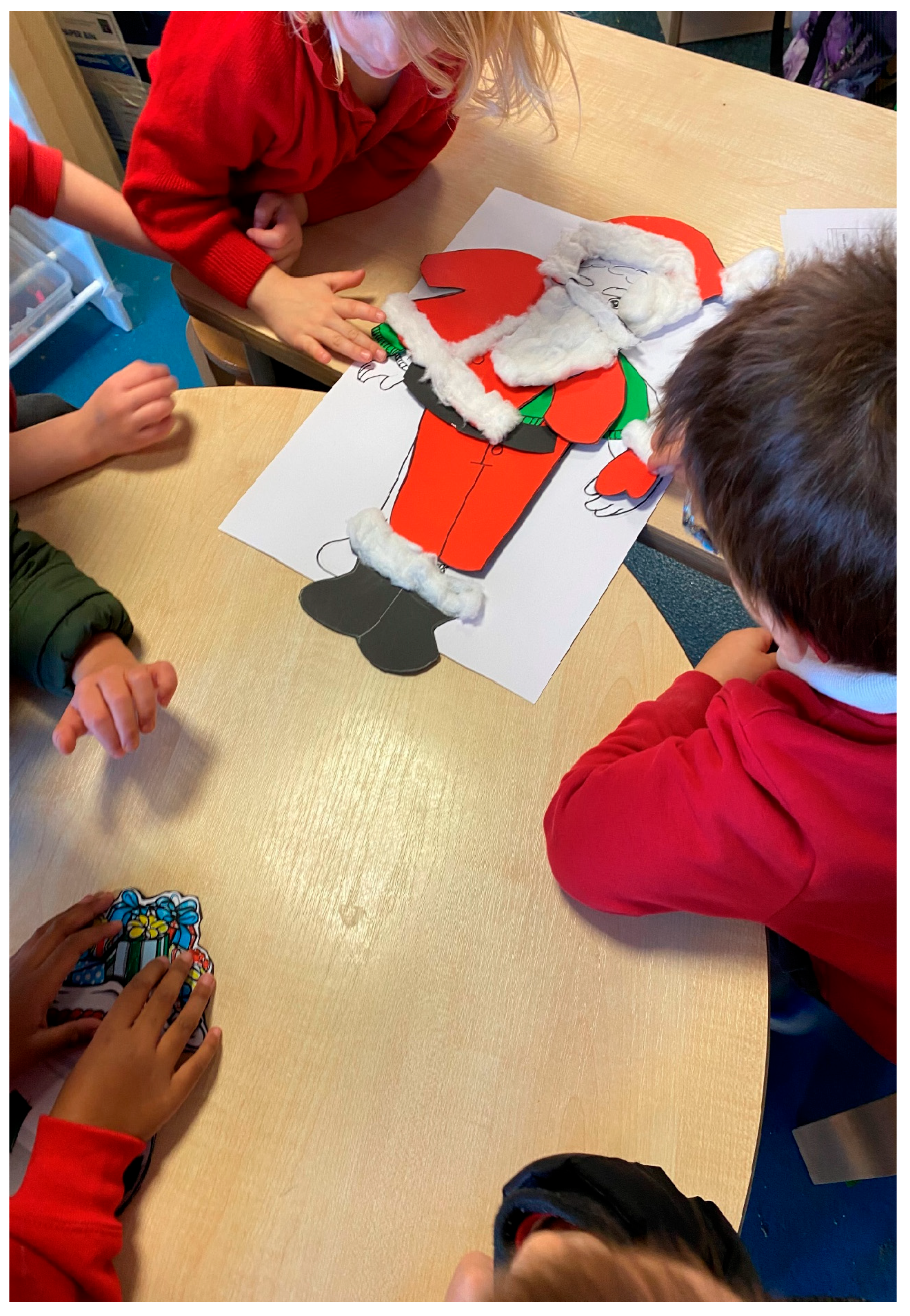
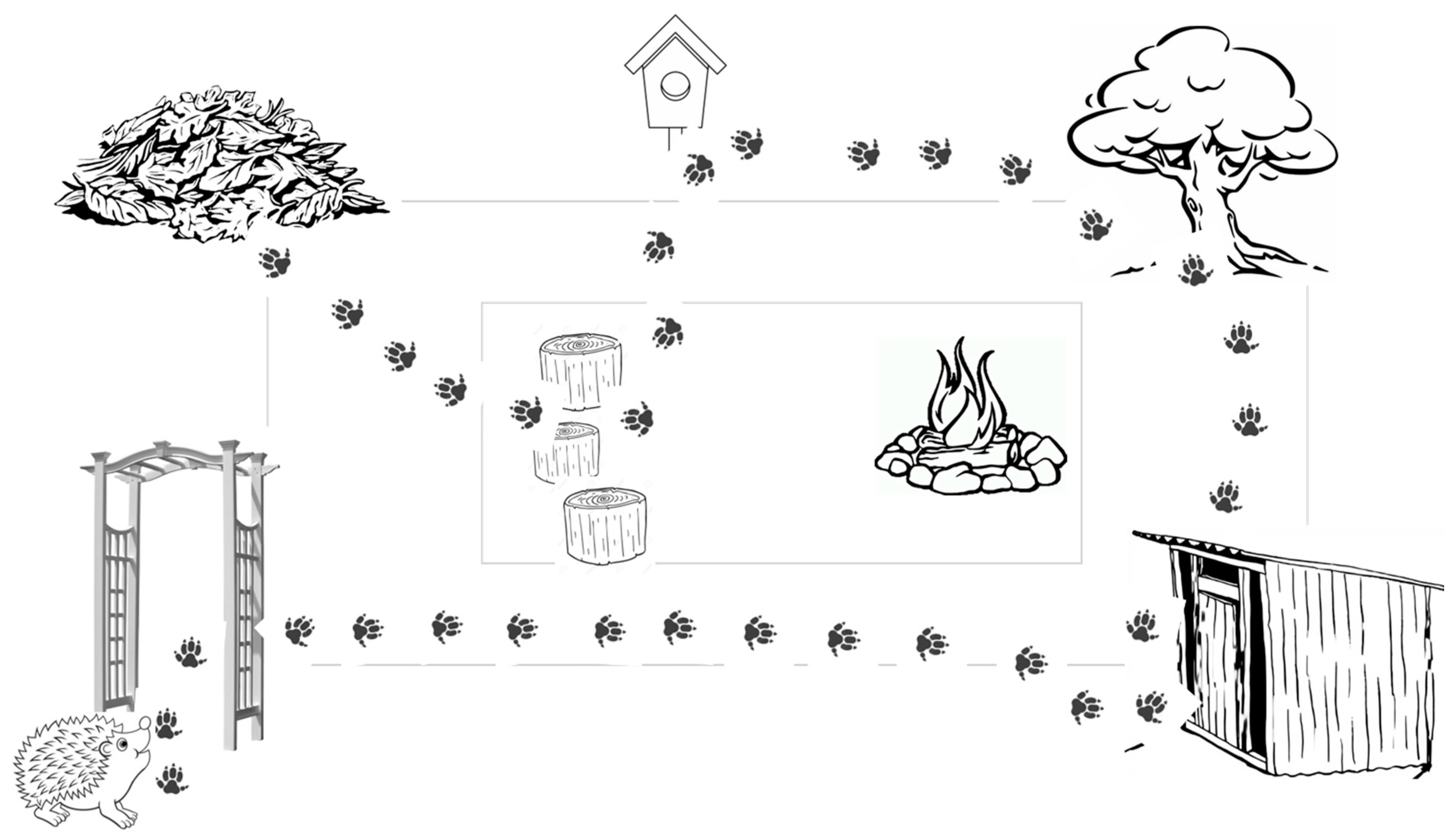
| EYFS Framework: Three Prime Early Learning Goals | Basics of CT Abilities That Can Be Taught at Preschool |
|---|---|
| Communication and language | Evaluating, deconstructing and debugging: Interactions with others; self-commentary; listening *; commenting *; asking questions; answering questions *; language development; vocabulary development * |
| Physical | Evaluating and sequencing algorithmic codes: Directionality *; sequences of movement; fine motor skills * |
| PSE | Evaluating and debugging: Friendships; interpersonal skills; modelling actions *, language and behaviour *; appropriate reactions *; celebrating * achievements |
| Other subjects: | |
| Mathematics | Deconstructing, sequencing and debugging algorithmic codes Ordering and sequencing *, pattern making |
| Understanding the world | Communication and collaboration: Widen personal experiences *; language development * |
| CT Skills and Activities | |
|---|---|
| Hello session Introduction to task A | Communication and collaboration: The children and researchers all say hello and tell everyone their names. One of the researchers introduces the main topic of the children’s task, showing pictures or physical materials and discussing with the children the nature of the activity. |
| Task A Familiarisation of task | Scaffolding provided to develop CT skills of deconstruction, evaluation, and language development (vocabulary, listening and answering questions): Children were asked to identify six correct items/pictures from a selection of 12 on a work sheet. The other six items were distractors. Each child had their own worksheet to circle the correct items, and either leave unmarked or cross out the incorrect items. A number of children were interviewed regarding their choices and to encourage debugging if there were errors. |
| Introduction to Task B Demonstration of activity | Scaffolding to develop CT skills of ordering, sequencing and directionality, language development (listening, commenting, answering questions) and fine motor skills: Children were shown an activity and asked questions about the task inviting their comments and suggestions. The children also took part in these activities, either by physically engaging in the task as a group, or by individually making something. |
| Task B Children apply activity | Scaffolding to demonstrate CT skills of ordering, sequencing and directionality, modelling actions, language development (listening, commenting, answering questions) and fine motor skills: Children were asked to apply their understanding of the activity previously demonstrated, comprising a pattern matching/sequencing task in session 1 and sequencing/ordering tasks in sessions 2–6. Children were interviewed by the researchers as they completed their worksheets to find out if they understood the activity, could explain it and could debug any errors. |
| Sessions | Themes | Equipment/Images |
|---|---|---|
| 1 | Wrapping a birthday present (pre-test) | Images for Task A: (correct) wrapping paper; pencil/pen; sticky tape; scissors; label; box (containing the present). Distractors: rubber bands; envelopes; doll; car; carrier bag, balloons. Task B: Pattern matching; continuing patterns: star- and circular-shaped stickers, worksheet with patterns to be copied or continued. |
| 2 | Forest School uniform | Task A: Images: (correct) trousers; wellingtons; vest and pants; socks; coat, hat, scarf and gloves. Distractors: umbrella; torch; sun-hat; sunglasses; sandals; handbag (see Figure 1). Task B: Six-box grid, six pictures: underwear; socks; jumper and trousers; coat; boots; hat, scarf and gloves. |
| 3 | Forest School map | Task A: Map of the Forest School Images: (correct) firepit; shed; birdbox; tree; arch; logs. Distractors: duck pond; candles, pot with flowers, swing, see-saw. Task B: Six-box grid, six pictures: archway, shed, tree, birdhouse, log, pile of leaves; map of route. |
| 4 | Icing a biscuit | Task A: Images: (correct) bowl; spoons; icing sugar; jug of water; biscuit; knife. Distractors: Plastic beaker; cupcake cases; rolling pin; egg whisk; biscuit cutter; tea strainer. Task B: Six-box grid, six pictures: spoon icing sugar in bowl; pour water in bowl, stir together; spoon icing on biscuit; spread icing; add chocolate heart. |
| 5 | Father Christmas outfit | Task A: Large picture of Father Christmas with cut-out clothes. Images: (correct) dungarees, jacket, jumper, hat, boots, sack of toys Distractors: fairy wings, woolly hat, sandals, Christmas tree; bells; sunglasses. Task B: Six-box grid, six pictures: jumper; dungarees; jacket and belt; hat; boots; sack of toys. |
| 6 | Wrapping a Christmas present | Task A: (correct) wrapping paper; pencil/pen; sticky tape; scissors; gift label; box (present). Distractors: rubber bands; envelopes; doll; car; carrier bag, balloons. Task B: Six-box grid, six pictures: box on paper; wrapped box in paper; using sticky tape; writing a label; sticking on a label; wrapped parcel. |
| Session 1 Birthday Present | Session 2 Forest School Uniform | Session 3 Forest School Map | Session 4 Icing Biscuits | Session 5 Father Christmas Outfit | Session 6 Christmas Present | |
|---|---|---|---|---|---|---|
| Number of children | 22 | 23 | 21 | 21 | 23 | 22 |
| Task A Correct/6 | ||||||
| Mean | 4.77 | 5.77 | 5.85 | 5.23 | 4.92 | 5.62 |
| Standard Deviation | 1.36 | 1.39 | 0.56 | 1.16 | 0.86 | 0.51 |
| Minimum | 2 | 5 | 4 | 2 | 3 | 5 |
| Maximum | 6 | 6 | 6 | 6 | 6 | 6 |
| No. of children maximum score | 7 | 19 | 19 | 11 | 12 | 13 |
| Task A Distraction/6 | ||||||
| Mean | 1.38 | 3.54 | 5.46 | 4.69 | 5.62 | 5.23 |
| Standard Deviation | 2.1 | 2.8 | 0.88 | 1.37 | 0.51 | 1.23 |
| Minimum | 0 | 0 | 3 | 2 | 5 | 3 |
| Maximum | 6 | 6 | 6 | 6 | 6 | 6 |
| No. of children max score | 3 | 7 | 12 | 5 | 12 | 10 |
| Researcher Questions | Emma’s Responses |
|---|---|
| (Points to the sun-hat) I wear a hat | |
| Do you wear that kind of hat in the winter? | (Circles the sun-hat) Yes |
| (Points to the sandals) Do you wear sandals in Forest School? | Yes |
| What, even in the winter? | Yes (circles the sandals) |
| (Points to the handbag) Would you wear that bag? | No, I have a little bag. |
| But would you wear this bag? (Points to the picture) | I’ve got a little bag though. (Circles the picture) |
| Session 1: Pattern Matching | Session 2: Forest School Uniform | Session 3: Henry Hedgehog Route | Session 4: Icing Biscuits | Session 5: Father Christmas Outfit | Session 6: Wrapping a Christmas Present | |
|---|---|---|---|---|---|---|
| No. of children | 22 | 23 | 21 | 21 | 23 | 22 |
| Mean | 3.82 | 3.36 | 6.0 | 4.36 | 3.27 | 4.27 |
| Standard Deviation | 1.78 | 2.1 | 0 | 1.8 | 2.1 | 1.9 |
| Minimum | 0 | 1 | 0 | 1 | 0 | 1 |
| Maximum | 6 | 6 | 6 | 6 | 6 | 6 |
| No. of children with 6 correct answers | 1 | 5 | 14 | 8 | 5 | 7 |
| Researcher’s Questions | Lee’s Responses |
|---|---|
| You have put Father Christmas’s hat first. Do you think that’s right? | Yes (miming putting on a hat) |
| But could he put his jumper on over his hat? | Yeah, he could put on… (mimed putting on the jumper) |
| Do you put your hat on before you put your clothes on in the morning? | But I don’t have a hat |
| So, you think that Father Christmas puts his hat on first? | Yeah |
| Do you think that Father Christmas puts his jumper on over or under his dungarees? | Under his dungarees |
| But you have got it over (points to picture code). Do you want to change it? | Yeah |
| Researcher’s Questions | Aalifa’s Responses |
|---|---|
| What’s happening in the picture? | (Points to the first picture) On the paper. (Points to the second picture) Putting on the paper. |
| Wrapping the paper round? | (Pointing to the third picture) Putting the sticky tape on. |
| Putting the sticky tape on? | (points to the fourth picture) Writing the label. |
| (Pointing to Pictures 5 and 6) Look, you’ve got the label on here, but here you are sticking it. Which way round is it? | (Gestured the correct way round) |
| Do you want to change that? You can pull it off (the picture) and change that if you want. | No, I don’t want to. |
| Why don’t you want to? | I just don’t want to. |
| OK, that’s fine. Well done! |
| Researcher | Soran |
|---|---|
| Points to Picture 1 Hello Soran. Tell me what is happening in your pictures. What is that in the box? (prompts) S……. | Soran points to the first picture but does not say anything. Shrugs his shoulders. Sugar |
| Points to Picture 2 What are you putting in the bowl? (prompts) Is it milk? | Says nothing, shrugs his shoulders. No. Water. |
| Points to Picture 3 And then what did we do? Gestures stirring. Stirring? Stirred | Gestures stirring. Stirred it. |
| Points to Picture 4 And then here, putting icing on the ….? (prompts) Bis…. | Shrugs Biscuit |
| Points to Picture 5 What’s happening here? Wiping? Spreading? | Gestures spreading the icing Spreading |
| Points to Picture 6 And then what are you doing here? | Put that on it (points to the chocolate heart). |
| That’s really good thinking Soran, well done! | Big smile and runs off. |
Disclaimer/Publisher’s Note: The statements, opinions and data contained in all publications are solely those of the individual author(s) and contributor(s) and not of MDPI and/or the editor(s). MDPI and/or the editor(s) disclaim responsibility for any injury to people or property resulting from any ideas, methods, instructions or products referred to in the content. |
© 2025 by the authors. Licensee MDPI, Basel, Switzerland. This article is an open access article distributed under the terms and conditions of the Creative Commons Attribution (CC BY) license (https://creativecommons.org/licenses/by/4.0/).
Share and Cite
Critten, V.; Hagon, H.; Critten, S.; Messer, D. Developing Computational Thinking Abilities in the Early Years Using Guided Play Activities. Educ. Sci. 2025, 15, 1298. https://doi.org/10.3390/educsci15101298
Critten V, Hagon H, Critten S, Messer D. Developing Computational Thinking Abilities in the Early Years Using Guided Play Activities. Education Sciences. 2025; 15(10):1298. https://doi.org/10.3390/educsci15101298
Chicago/Turabian StyleCritten, Valerie, Hannah Hagon, Sarah Critten, and David Messer. 2025. "Developing Computational Thinking Abilities in the Early Years Using Guided Play Activities" Education Sciences 15, no. 10: 1298. https://doi.org/10.3390/educsci15101298
APA StyleCritten, V., Hagon, H., Critten, S., & Messer, D. (2025). Developing Computational Thinking Abilities in the Early Years Using Guided Play Activities. Education Sciences, 15(10), 1298. https://doi.org/10.3390/educsci15101298











